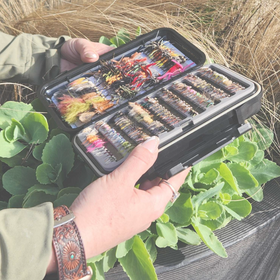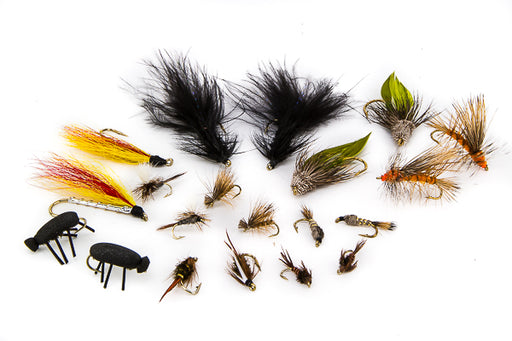
Fly Hooks and Hook Sizing
We get a lot of phone calls and emails here. There are a few that we get enough that it warrants a blog post.

These are all size 12
We use a couple of different brands of hooks here at Big Y Fly Co. Over 90% of our trout flies use either a Firehole brand or Daiichi brand hooks. You will not find other companies using these high quality hooks with any consistency.
We do stock over a million flies at a time here at Big Y Fly Co. Volume means better margins when buying hooks. Our tiers get the best possible deal on Daiichi hooks, because we buy the most Daiichi hooks, period.
Daiichi is the straight up best hook on the market. If course that is just my opinion, but it is shared by a solid majority of fly tiers. There are some that prefer a Tiemco hook, but after 20+ years of tying flies, I think that Daiichi makes the best hook out there. Either way, TMC and Daiichi hooks are nearly identical in size and quality when comparing similar styles. Daiichi hooks are more consistently available in the quantities that we need.

Firehole Hooks are a hot, relatively new brand in the fly tying world. They make some really interesting hooks that are a bit different than the norm. Most have a non-traditional bend, and they are all very well designed and produced. For the most part, we use their hooks for our Euro style patterns. Their hooks are sharp, consistently high quality and readily available.
Features in a hook
We can find several attributes to any style of hook. Wire gauge (diameter), gap size (width of gap between the shank and the point), shank length, eye size, eye direction (upturned, straight, downturned), and style of bend. These all affect how the fly looks and performs. The variations are labeled like 1x and 2x. A 1x long hook shank will have a shank length equivalent to a standard hook that is one size larger, a 2x long hook has a hook shank equivalent to a standard hook that is 2 sizes larger.
Trout Hooks at Big Y
Most of our nymphs and dries are tied on a "standard" size hook. This is the hook that sets the standards for sizing on all other hooks. We use it on the most patterns in the shop. We use the Daiichi 1550 for most patterns.

The 1550 is our most used hook
The 1550 has a standard wire gauge, standard gap, standard shank length and a Sproat bend. The styles of bends all have different names, but the sproat is the most common., with a "round bend" being the next most common. Other bends include the Aberdeen, Limerick, Kirby and Sneak, but there are dozens of bends.
You will find the Daiichi 1550 hook on most of our basic nymphs; copper johns, hare's ears, pheasant tails, etc...
I will note that several "discount" fly companies use a 1x long hook on a majority of their nymph patterns. We do not think that they look as nice as the standard length. We prefer this hook as it is the "standard". I believe that commercial tiers prefer the longer hooks as there is more room to work with on the shank, which is why many of the other "discount" fly companies use them.

1180 Dry Fly Hook
Most dry flies are tied on this same Daiich 1550 or a Daiichi 1180. The 1180 is Daiichi's standard dry fly hook. There are only two differences are that the 1180 has a "mini barb" and a "round bend" instead of a "Sproat bend". Otherwise they have the same features, wire gauge and downturned eye, and most folks cannot tell the difference, especially on a finished fly.
There are some hooks that are used sparingly in our catalog. A Daiichi 1560 is a "1x long" nymph hook. It is equivalent to the length of a 1550, but the shank is one size longer and one wire gauge heavier. So a Daiichi 1560 #14 has the same length shank and wire diameter as a Daiichi 1550 #12, but all other features will be the same as a 1550 #14.

Daiichi 1120 is heavy-duty
This continues with the Daiichi 1710 (2x long) and the Daiichi 1720 (3x long). Those two hooks are typically featured on damselfly and dragonfly patterns, but we do not have many patterns tied on those hooks. We typically use a streamer hook that is 4x long for most of those patterns.
Another commonly used hook is the Daiichi 1270. This is usually called the "Stimulator Hook". It has a straight eye, a 3x long shank and a "York" bend. We use it plenty on stonefly patterns, stimulators, and a few other patterns. It works great for beadheads and dry flies, lake flies and rivers.
One more hook that is commonly used here at Big Y Fly is the Daiichi 1120 curved nymph hook. This badboy is 2x strong, so it is also used on many of the steelhead nymphs, but more commonly on curved nymph patterns like a Barr's Emerger, scud, sow bug or brassie, as well as most of our egg patterns. The 1120 has a "continuous bend", a 1x short shank and a 2x strong wire. Fantastic for so many different patterns and one of the most popular hooks on the market. This hook very rarely bends or breaks and has a good track record of staying right in the corner of a trout's mouth.

2220 - streamers and stoneflies
The Daiichi 2220 is called a streamer hook, but it is far more useful than just streamers. It is 1x heavy gauge wire and a 4x long hook shank. We use this hook for a large quantity of patterns. A majority of our streamers, leeches, baitfish patterns are tied on this hook. We also use it on many of our foam dry flies and hoppers. This hook is strong, but not so heavy that it will sink a big dry fly. We have spent many, many hours testing these hooks and making determinations on how well they hold up, and we have determined that this is the best hook to use on those patterns. This is standard across the industry with those big foam patterns.
Every fall, just as predictable as the salmon migration, anglers from the Great Lakes region call us to say that their trout hooks are bending or breaking on big Chinook salmon. One simple reason is that these are trout hooks. A large trout is 5 pounds in most places. A small Chinook is 15 pounds. Chinook also like to "dog down" when they fight. They do everything they can to get right back to the spot where they were hooked and stay there. This is like pulling in dead weight, which most folks know is much harder than pulling in moving weight like a trout.

Firehole 516 for Euro Jigs
It puts extra strain on a hook that is 4x long, but only 1x strong. That means that the hooks shank is less than half the wire strength of a similar hook that is standard sizing. The extra length also makes a 2220 susceptible to bending under immense pressure. It is basic leverage principles of physics. The Daiichi 2151 and 2161 Salmon hooks are 4x heavier wire than a 2220. A salmon hook is far more likely to hold a salmon than a trout hook.
Euro Hooks
Euro-style flies are all the rage. They work great. I am a fan. Most of these "Euro nymphs" are tied on one of two hooks. A Firehole 516 jig hook, and a Firehole 637 nymph/wet/egg hook. The 516 has a 60 degree jigged eye on it with a standard length shank and a 1x wide gap. We love this hook for our jig flies, and it is found on almost all of them.

637 is short, wide and strong
The 637 is a the hook used on our Perdigon style flies. It is a bit different, as it has a 1x short shank and a 2x wide gap, making this a very large gap ratio to the shank. This is the most common pattern and hook that we get emails and phone calls about. The wide gap means that a fish is more likely to get a fly stuck with less effort, and it allows the angler to fish a smaller bodied fly without sacrificing a bigger hook gap, plus this is the hook style that is used on Perdigon flies across the industry.
All of the Firehole hooks are barbless, which means that all of our Euro style flies that are tied on these hooks are barbless as well. We do have several patterns that are considered Euro patterns and are tied on Daiichi hooks as that is what the recipe called for.
Saltwater Hooks

SC15 for most Tarpon flies
While the majority of our trout hooks are Daiichi or Firehole, we have a bit of variety with saltwater hooks. Saltwater hooks are much stronger than trout hooks and feature stainless steel, tin or black nickel finishes that resist corrosion.
The hooks can vary from pattern to pattern, we have a good chunk of these tied on a Daiihci 2546. This hook is strong, strong, strong. With any stainless steel hook, anglers must sharpen the hooks themselves as chemical sharpening is not effective on this material.

2546 for many saltwater patterns
We have a few patterns that are tied on Gamakatsu SC15 hooks. This is a favorite tarpon hook for many and we use it on patterns that called for it in the recipe.
Which hook for what pattern?
So different types of flies will be tied on different styles of hooks. Mayfly and caddis imitations tend to be tied on standard size hooks. Some on curved, some on straight hooks. Caddis patterns are more likely to come in on that 1560 1x long hook, but most are on the 1550.
If the fly seems like a large pattern, it will likely be tied on a large hook. Those itty-bitty patterns are tied on a smaller hook.
Dragonfly, grasshopper and stonefly imitations are larger and tend to be tied on larger hooks. We use the 1270 stimulator hooks and 2220 streamer hooks for a good chunk of those patterns, but there are always some outliers. If you ever have any questions, please feel free to ask.
Other patterns

Daiichi 2720 for Bass flies
Many of our Bass patterns are tied on a Gamakatsu B10S stinger hook or the Daiichi equivalent, the 2720. This style of hook is hugely popular in the bass world. We try to put the hair poppers on those hooks. Other bass patterns use that 2546 saltwater hook. Any pattern that we suspect might be used for muskie or saltwater fishing will more likely use the 2546.
As mentioned earlier, many of our steelhead/salmon patterns use a Daiichi 2161 hook. This is the right hook for steelhead and salmon. They have the iconic black finish and swim right in the water when swung across a riffle.
Other salmon patterns have a wire and trailer hook system. We typically use a Gamakatsu or Daiichi Octopus style hook for these. This hook style has maximum stick without the possibility of bending, due to the short shank.
Quality Control and Product Development
We try our best to use the right hooks in the most appropriate patterns. We do our best to reflect the hook choice of the pattern's creator to a point. We prefer to use the hook styles that we already have plenty of access to. We try to not create a pattern that requires a specialty hook when a standard hook would be more than sufficient. Those specialty hooks can be hard to source on a consistent basis and tend to lead to QC issues later down the road when the right hook can't be sourced in the right quantities. We do have a few patterns tied on hooks that are only used on that one pattern. Al's Rat is one.
Does every standard trout fly come in on Daiichi hooks every time? Short answer, no. There have been occasional sourcing issues when a tier cannot get enough Daiichi hooks and we have had to use other brands of similar hooks. This was a bit of an issue during 2020, when the global supply chain took a hit. Most of those issues have worked themselves through the system, and we have been seeing very few hook issues over first part of 2022.
Even Daiichi has a few production hiccups. We have seen hooks with eyes that are not completely closed as well as as weird bent points. I have even seen two hooks fused together more than once. We do our best to sort those out so you do not have to see it, but they might slip through occasionally.
Tiers also have occasionally hiccups. They have tightened the vise down too hard and damaged the bend of the hook, or bent the hook trying to remove it from the vise. All of these are possibilities, but these tiers usually nail it. They tie flies all day long, day in and day out. Most of them tie more flies in a week than we will tie in a lifetime. They do a fabulous job even if there is an occasional bum fly in the batch, and we could not be happier to have them as part of our Big Y Family.









